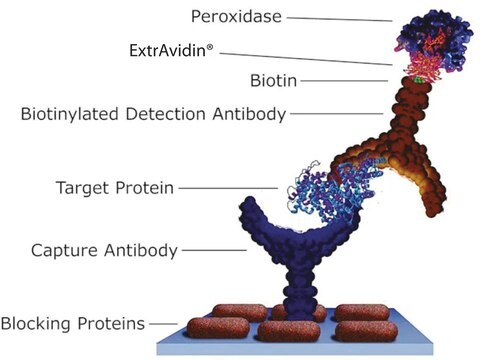EXTRA2
Mouse ExtrAvidin® Peroxidase Staining Kit antibody produced in goat
Synonym(s):
ExtrAvidin® Peroxidase Staining Kits
About This Item
Recommended Products
antibody product type
secondary antibodies
Quality Level
usage
sufficient for 2,000 tests ELISA, Immunoblotting
sufficient for 200 tests Immunohistology
shipped in
wet ice
storage temp.
2-8°C
target post-translational modification
unmodified
Looking for similar products? Visit Product Comparison Guide
Related Categories
General description
ExtrAvidin® is a unique form of avidin, available only from Sigma, that combines the high specificity and affinity of avidin for biotin with low non-specific binding at physiological pH. ExtrAvidin® peroxidase exhibits high sensitivity with low background.
Application
Immunohistochemistry (1 paper)
Features and Benefits
- Use in immunohistology, ELISA, and immunoblotting assays.
- Affinity Isolated Antibodies have been adsorbed with human IgG and IgM to minimize cross-reactivity.
- Biotinylated antibodies contain a spacer which improves accessibility for the ExtrAvidin® conjugates.
Components
• 3 mL Biotinylated Secondary Antibodies
• Complete Instructions and Assay Protocols
Legal Information
Not finding the right product?
Try our Product Selector Tool.
Storage Class Code
12 - Non Combustible Liquids
WGK
WGK 3
Flash Point(F)
Not applicable
Flash Point(C)
Not applicable
Personal Protective Equipment
Certificates of Analysis (COA)
Search for Certificates of Analysis (COA) by entering the products Lot/Batch Number. Lot and Batch Numbers can be found on a product’s label following the words ‘Lot’ or ‘Batch’.
Need A Sample COA?
This is a sample Certificate of Analysis (COA) and may not represent a recently manufactured lot of this specific product.
Already Own This Product?
Find documentation for the products that you have recently purchased in the Document Library.
Our team of scientists has experience in all areas of research including Life Science, Material Science, Chemical Synthesis, Chromatography, Analytical and many others.
Contact Technical Service